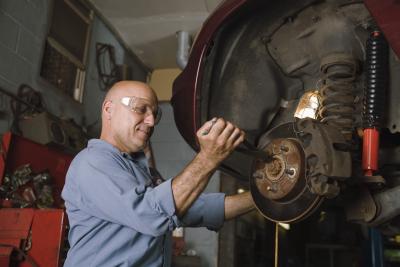
There are many variables to consider before replacing your brake pads. Vehicles are manufactured with a specific type of brake pads and almost all vehicle manufactures strongly recommend replacing pads with the same base pad the vehicle came with. However, there are both benefits and side-effects, depending on the application, to switching brake pad types on your vehicle.
Original equipment pads can come in a variety of different materials. This depends on vehicle weight and braking distribution. Non-asbestos organic pads, semi-metallic pads and ceramic pads may be featured on the vehicle from the manufacturer. Whether or not switching the type of pad on your brakes will be beneficial is a difficult question. The answer is maybe or maybe not. While you may achieve one or two of your desired intentions from switching brake pad composition types, you may find adverse side-effects by switching.
One of the difficulties of switching to OEM ceramic break pads is that there is more than one type of ceramic pad. Although all are labeled ceramic, their composition may differ. It can cost you time and money figuring out which composition of pad is the best for your needs.
Your largest barrier to finding out what's best for your vehicle is that the vehicle manufacturers, the aftermarket brake pad manufacturers and the brake installation centers are not all on the same page. Conflicting information from all three can confuse you and the more information you absorb about the matter, the less you have may feel you have learned. Dealerships are going to want to sell you OEM pads, aftermarket companies are going to want to sell you their pads and installation centers are going to want to sell you what they have in stock. This is equivalent to calling a ski resort to find out the conditions before you head out for the slopes. They're not going to tell you it's icy so don't bother coming. They'll use a term like "frozen packed granular."
There are many differences of opinions on break pads. Some think ceramic pads are more forgiving to the surface of the rotor, while others think their harder pad composition makes them less forgiving.
Ceramic pads, as any other type, can comprise up to 20 different ingredients. Most often, ceramic pads do not use metal fibers or steel wool. However, there are also semi-ceramic pads which may contain these products. A true ceramic pad integrates ceramic pieces and copper filings. This makes a harder brake pad then semi-metallic; however, depending on the weight of the vehicle and it's friction heat factor, it may not produce the same stopping distance as the semi-metallic. Consider the next contradiction. A true ceramic pad will produce less brake dust that clings to the wheels of a vehicle. If this is a desired intent, you may be trading aesthetic value over braking power.
Many believe that semi-metallic pads are the most aggressive pad on the market. Metal filings and steel wool will produce unsightly brake dust on wheels and emit annoying brake squeals when under demand. The metallic composition is believed to be the harshest on rotor surfaces, but again this depends on the vehicle application. Others believe ceramic pads produce more noise and rotor deterioration.
If you own a large truck or SUV and want to switch from semi-metallic to ceramic brake pads, the best answer is probably don't. The braking temperature will exceed what the ceramic pads can handle and this can be a safely hazard. If you have a smaller vehicle and concerned with brake dust, brake squeals or warping rotors, by all means, throw the dice and take the gamble. You may find the ceramic stops better than the semi-metallic and still achieves other intentions like minimal brake dust and braking noises.
Many parts stores and aftermarket brake pad companies offer lifetime warranties on their pads. If you do not accomplish the desired outcome with the conversion, many will allow you to upgrade (for a small fee) or downgrade (usually with no refund) to achieve the type of braking you're looking for.